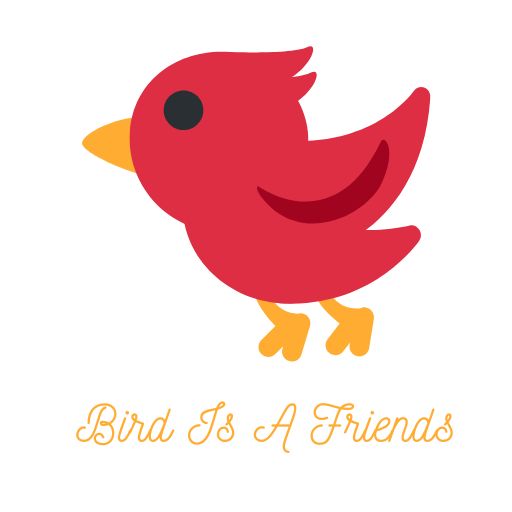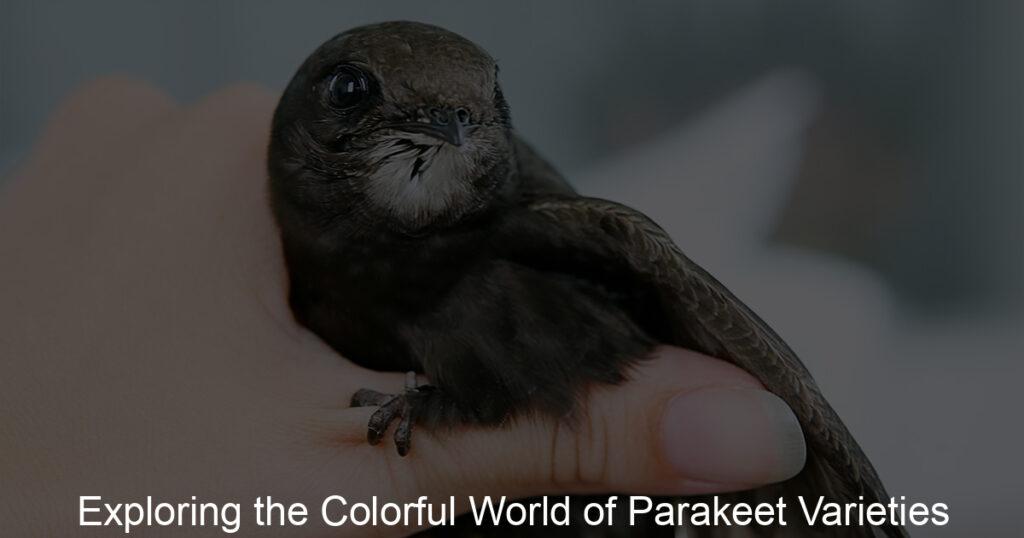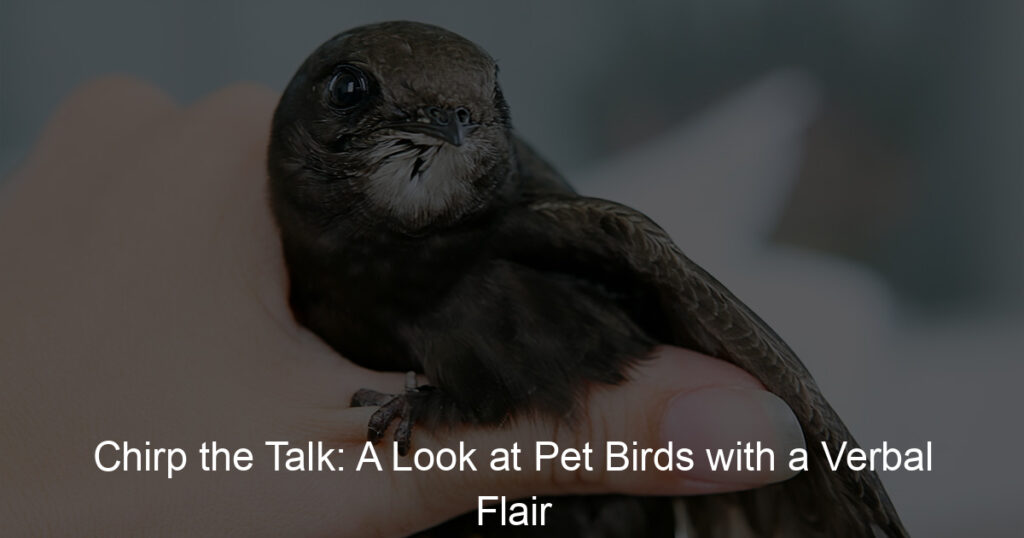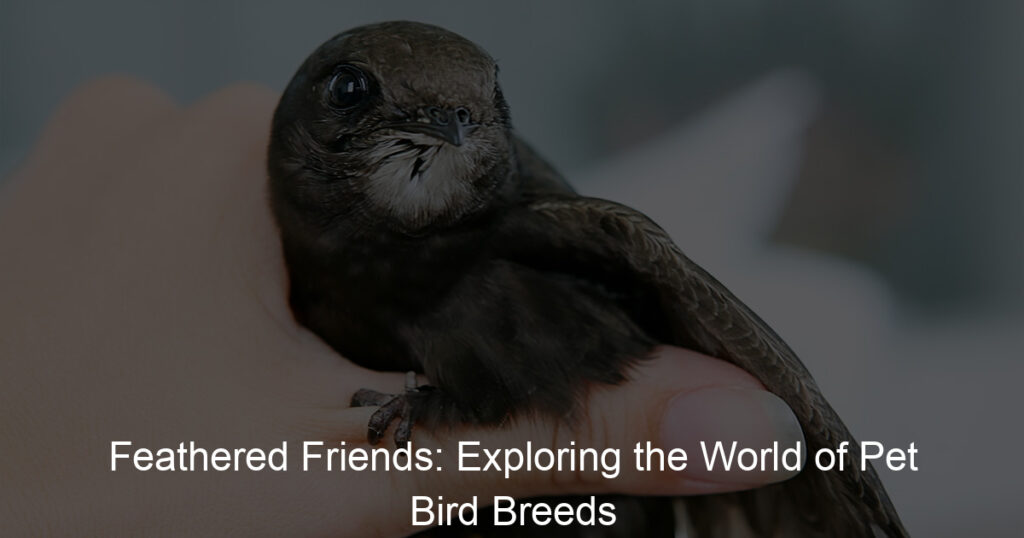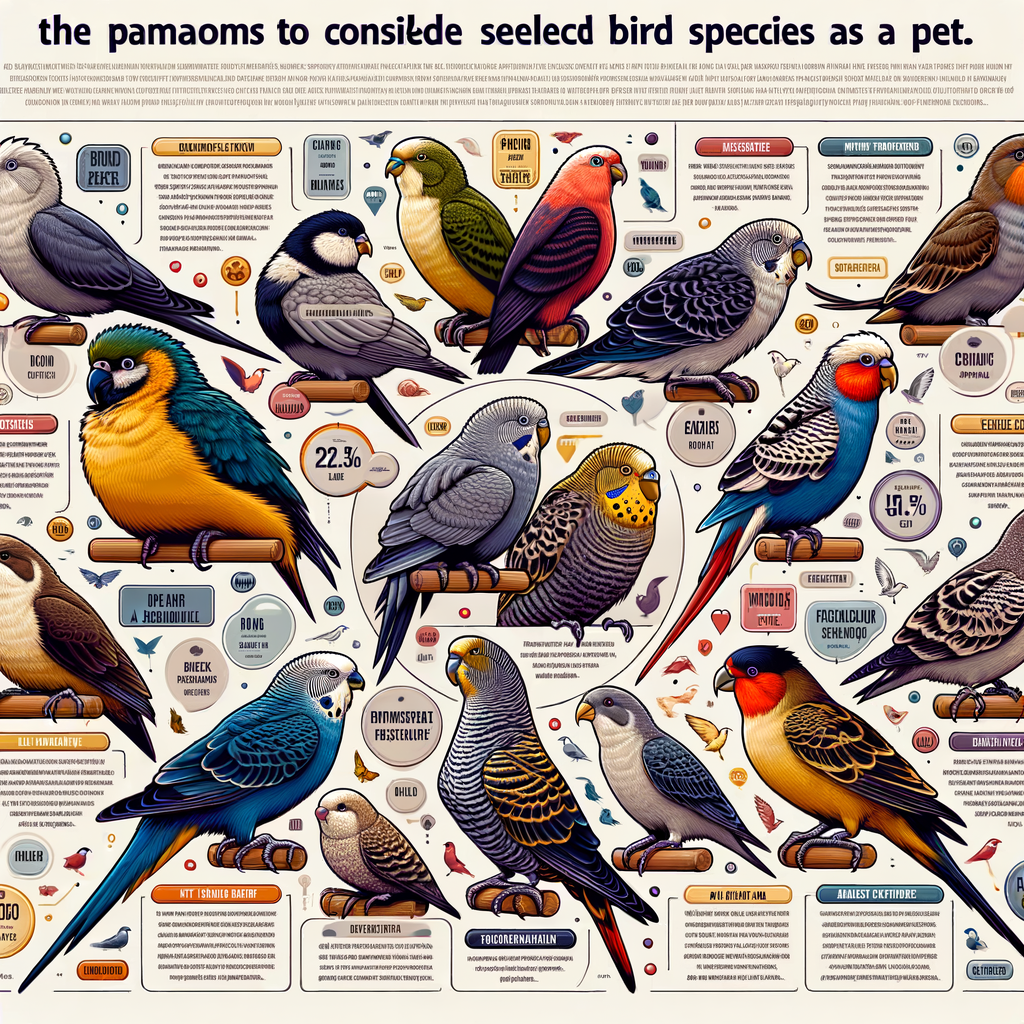
Introduction to Bird Species Selection
Choosing a bird as a pet can be a delightful experience. However, it’s important to select the right species to ensure a harmonious relationship. This section will guide you through the importance of choosing the right bird species and the factors to consider during the selection process.
- Understanding the Importance of Choosing the Right Bird Species
- Factors to Consider in Bird Species Selection
- Lifespan: Some birds can live for several decades. Ensure you’re ready for a long-term commitment.
- Size: Larger birds generally require more space and care than smaller ones.
- Diet: Different bird species have different dietary requirements. Some birds eat seeds, while others need a varied diet including fruits, vegetables, and proteins.
- Behavior and Temperament: Some birds are social and require a lot of interaction, while others are more independent.
- Cost: Some bird species are more expensive to care for due to their dietary requirements and healthcare needs.
Choosing the right bird species is crucial for both the bird and the owner. Different bird species have different needs, behaviors, and lifespans. For instance, some birds are social and require a lot of interaction, while others prefer solitude. Some bird species live for a few years, while others can live for several decades. Therefore, it’s essential to choose a bird species that aligns with your lifestyle and commitment level.
Several factors should be considered when choosing a bird species. These include:
By considering these factors, you can choose a bird species that fits your lifestyle and provides a comfortable and fulfilling life for the bird.
Understanding Different Bird Species
When it comes to bird species, the variety is vast and fascinating. Each species possesses unique characteristics, behaviors, and needs. In this section, we will focus on some of the most common bird species that people often choose as pets.
Common Bird Species for Pets
There are numerous bird species that make excellent pets. Here, we will discuss three of the most popular ones: Parakeets, Canaries, and Cockatiels.
- Parakeets
- Canaries
- Cockatiels
Parakeets, also known as budgies, are small, colorful birds that are known for their playful and social nature. They are intelligent and can be trained to perform tricks and mimic sounds. Parakeets require a lot of interaction and mental stimulation, making them a great choice for families and individuals who can devote time to their care.
Canaries are renowned for their beautiful singing abilities. These small birds come in a variety of colors and are relatively easy to care for. Canaries are not as social as parakeets and often prefer to be alone. They are a great choice for individuals who enjoy listening to bird songs but may not have as much time for interaction.
Cockatiels are larger than both parakeets and canaries, and they are known for their distinctive crest feathers. These birds are friendly, affectionate, and can be trained to mimic tunes. Cockatiels require a balanced diet and plenty of exercise, making them a suitable choice for individuals who can provide a spacious environment and dedicated care.
In conclusion, Parakeets, Canaries, and Cockatiels each offer unique qualities that can make them wonderful pets. The key is to understand their specific needs and behaviors to ensure a happy and healthy environment for them.
Exotic Bird Species
When it comes to bird species, there are a few that stand out due to their unique characteristics and stunning beauty. These are often referred to as exotic bird species. Let’s explore some of the most popular ones:
- African Grey Parrots
African Grey Parrots are known for their intelligence and ability to mimic human speech. They are native to the rainforests of West and Central Africa. Their feather color is predominantly grey, with a beautiful contrast of a bright red tail. They can live up to 60 years, making them a long-term commitment for any bird owner.
- Macaws
Macaws are large, colorful parrots native to Central and South America. They are known for their vibrant feathers that come in a variety of colors, including blue, green, red, and yellow. Macaws are social birds and require a lot of interaction and stimulation. They can live up to 80 years, which is one of the longest lifespans among bird species.
- Cockatoos
Cockatoos are native to Australia and Indonesia. They are recognized by their distinctive crests and curved beaks. Cockatoos are known for their playful and affectionate nature. They can live up to 70 years and require a lot of care and attention.
| Species | Native To | Lifespan |
|---|---|---|
| African Grey Parrots | West and Central Africa | Up to 60 years |
| Macaws | Central and South America | Up to 80 years |
| Cockatoos | Australia and Indonesia | Up to 70 years |
Remember, owning an exotic bird is a big responsibility. They require a lot of care, attention, and a suitable environment to thrive. Make sure you are fully prepared before bringing one of these beautiful creatures into your home.
Tailored Advice for Bird Owners
As a bird owner, it’s important to make informed decisions that suit your lifestyle and the needs of your feathered friend. This section offers advice on how to choose a bird based on your lifestyle.
Choosing a Bird Based on Lifestyle
When it comes to selecting a bird, your lifestyle plays a significant role. Two key factors to consider are your time commitment for bird care and understanding the lifespan of different bird species.
- Assessing time commitment for bird care
- Understanding the lifespan of different bird species
Firstly, owning a bird requires a significant time commitment. Birds are social creatures that need interaction, exercise, and mental stimulation. Some species, like parrots, need several hours of interaction each day. If you’re often away from home or have a busy schedule, you might want to consider a bird species that requires less interaction, like finches or canaries.
Secondly, it’s essential to understand that different bird species have different lifespans. Some birds, like budgies or cockatiels, can live for 10-15 years, while larger parrots can live up to 60 years or more. Owning a bird is a long-term commitment, so it’s important to choose a bird whose lifespan aligns with your ability to care for it.
In conclusion, choosing a bird that fits your lifestyle is crucial for both your happiness and the wellbeing of the bird. By considering your time commitment and understanding the lifespan of different bird species, you can make an informed decision that benefits both you and your new feathered friend.
Selecting a Bird Based on Space
When choosing a bird as a pet, it’s essential to consider the space you have available. This includes not only the size of the bird but also its need for flight and movement. Let’s delve into these two crucial factors.
- Considering the size of the bird
Different bird species vary significantly in size. For instance, a Budgerigar is a small bird that only requires a small cage for its comfort. On the other hand, larger birds like Macaws need more space to move around and stretch their wings. Therefore, the size of your bird will directly impact the amount of space you need to dedicate to its habitat.
| Bird Species | Approximate Size |
|---|---|
| Budgerigar | 18 cm |
| Macaw | 100 cm |
- Understanding the bird’s need for flight and movement
All birds, regardless of their size, need some level of physical activity. This is particularly true for birds in captivity. Birds need to fly and move around to maintain their physical and mental health. Therefore, even if you have a small bird, you should still provide an environment where it can fly and explore. This might mean dedicating a safe room where your bird can fly freely, or investing in a large cage that allows for flight.
In conclusion, when selecting a bird based on space, it’s crucial to consider both the size of the bird and its need for movement and flight. By taking these factors into account, you can ensure that your bird has a happy and healthy life in your care.
Bird Ownership Tips
Whether you’re a first-time bird owner or a seasoned avian enthusiast, there are always ways to improve your bird care skills. In this section, we will discuss some essential tips on preparing your home for a bird.
Preparing Your Home for a Bird
Before bringing a bird into your home, it’s crucial to ensure that your home environment is safe and comfortable for your new pet. Here are some key steps to take:
- Creating a safe and comfortable bird habitat: Birds need a space where they can fly, play, and rest. Remove any toxic plants, secure loose wires, and ensure there are no small gaps where a bird could get stuck. Also, keep the temperature in the room comfortable, as birds are sensitive to temperature changes.
- Choosing the right bird cage: The cage is a significant part of your bird’s habitat. It should be spacious enough for your bird to move around comfortably. The bars should be close enough together to prevent your bird from escaping or getting its head stuck. The cage should also have a secure door and a removable bottom tray for easy cleaning.
Remember, a happy bird is a healthy bird. By creating a safe and comfortable environment and choosing the right cage, you can ensure that your bird feels at home and thrives in your care.
Feeding Your Bird
Feeding your bird properly is crucial to their health and happiness. The right diet can make a significant difference in your bird’s mood, energy levels, and overall wellbeing. Let’s delve into understanding the diet of different bird species and how to choose the right bird food.
- Understanding the Diet of Different Bird Species
Just like humans, different bird species have different dietary needs. Some birds are granivores, meaning they primarily eat seeds and grains. These include species like canaries and finches. Other birds, like parrots and cockatiels, are omnivores, eating a mix of seeds, fruits, vegetables, and occasionally, insects or meat.
Then we have nectarivorous birds like hummingbirds that feed on nectar and small insects. Birds of prey, such as hawks and eagles, are carnivores and eat a diet primarily of meat. Understanding your bird’s natural diet is the first step to providing them with proper nutrition.
- Choosing the Right Bird Food
Once you understand your bird’s dietary needs, the next step is choosing the right bird food. Commercial bird food comes in many forms, including pellets, seeds, and specially formulated diets. It’s important to choose a food that is specifically designed for your bird’s species.
For example, seed mixes for canaries and finches should contain a variety of seeds like millet, canary seed, and niger. Parrot food, on the other hand, should include a mix of seeds, fruits, and vegetables. Always ensure that the food you choose is fresh and free from mold or other contaminants.
In addition to commercial bird food, it’s also beneficial to supplement your bird’s diet with fresh fruits and vegetables. These provide essential vitamins and minerals that can boost your bird’s health. However, remember to wash all fresh produce thoroughly before feeding it to your bird to remove any pesticides or other harmful substances.
Feeding your bird is not just about providing food. It’s about understanding their dietary needs and providing a balanced diet that mimics what they would eat in the wild. With the right diet, your bird can live a long, healthy, and happy life.
Conclusion: Selecting the Right Bird
As we draw to a close, it’s crucial to remember that choosing the right bird species for you is a personal journey. It involves understanding the bird species, their needs, and how well they align with your lifestyle. Let’s recap some of the key points we’ve covered in this guide.
- Recap of key points in bird selection:
- Final thoughts on finding the perfect bird species for you:
Firstly, we discussed the importance of understanding different bird species. Each bird species has unique characteristics, behaviors, and needs. For instance, some birds are social and require constant interaction, while others are more independent. We also highlighted the significance of considering your lifestyle and environment when selecting a bird. For example, larger birds typically require more space and care than smaller ones.
Next, we provided tailored advice for bird owners. We emphasized the importance of regular veterinary check-ups, providing a balanced diet, and ensuring your bird has enough mental and physical stimulation. We also shared some useful bird ownership tips, such as the importance of bird-proofing your home and understanding bird body language.
In conclusion, finding the perfect bird species for you is a rewarding journey that requires time, research, and patience. It’s not just about choosing a bird that you find attractive, but also one that fits well with your lifestyle and personality. Remember, owning a bird is a long-term commitment that can last for many years, so it’s crucial to make an informed decision.
By following the advice and tips provided in this guide, you’ll be well on your way to finding a feathered friend that brings joy and companionship into your life. Happy bird hunting!
